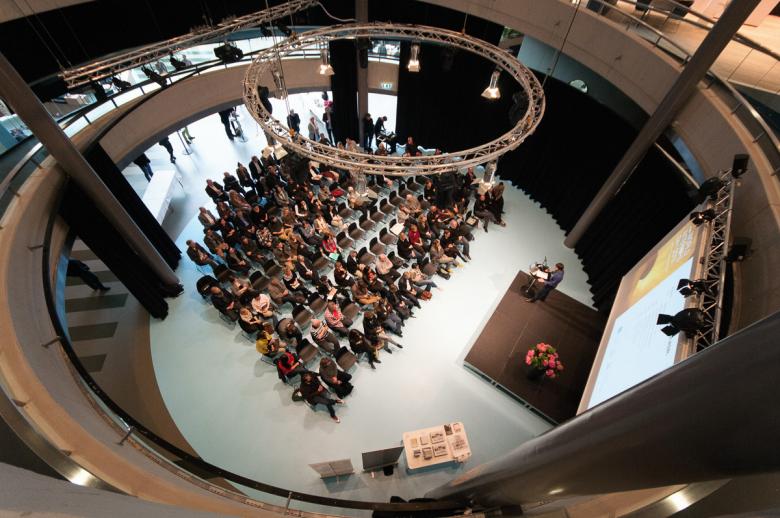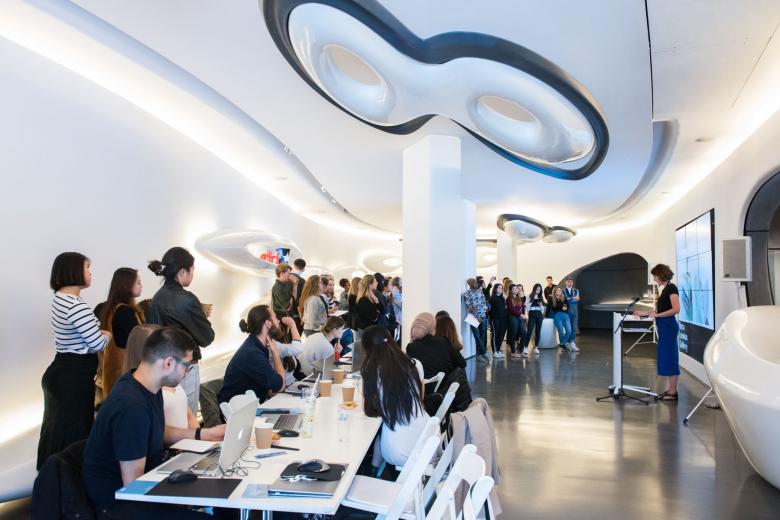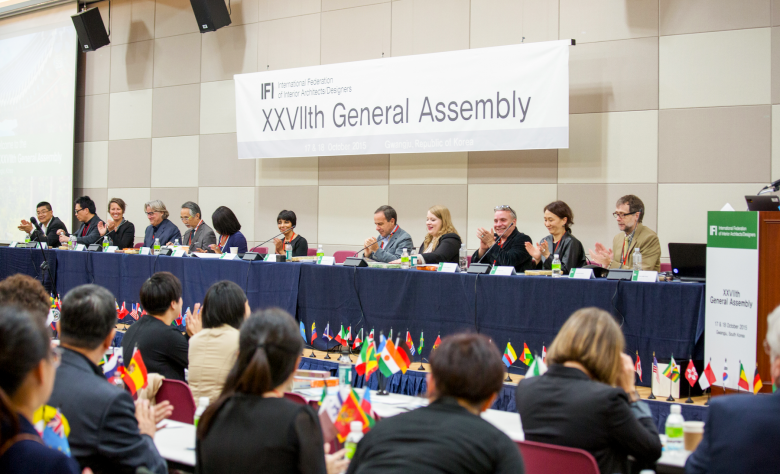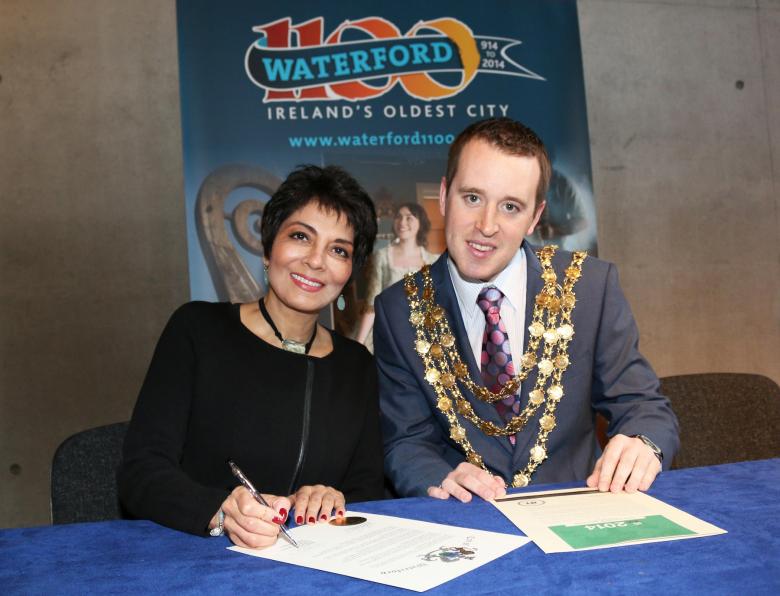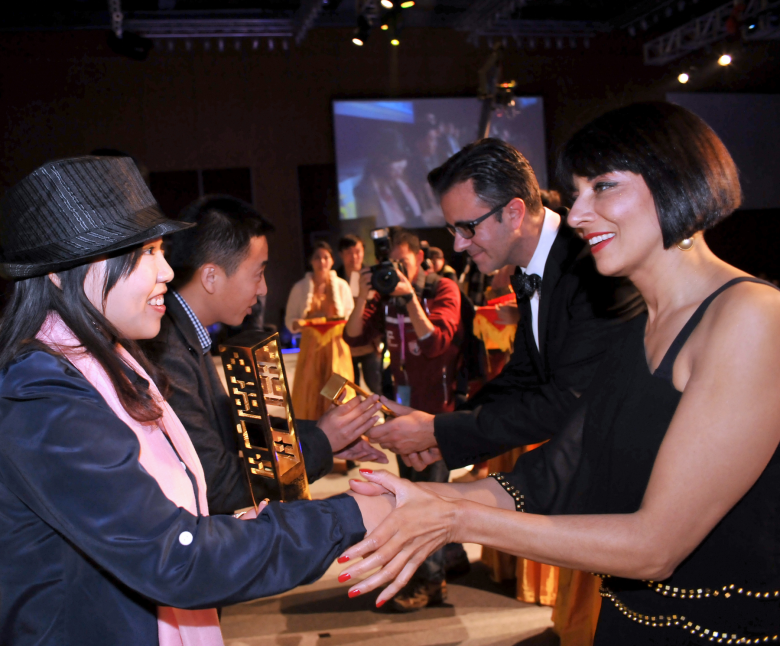25. January 2024
Speaker session at Stilhaus in Rothrist, Switzerland organized by IFI member Vereinigung Schweizer Innenarchitekten/Architektinnen (VSI.ASAI). — All images are courtesy of IFI.
World-Architects Editor in Chief John Hill spoke with Shashi Caan, CEO of IFI – International Federation of Interior Architects/Designers, about how IFI works, the challenges interior architects and designers face today, Caan’s career leading up to IFI and her role as CEO, and IFI’s Global Awards Program, the winners of which will be announced in March.
John Hill (JH): For readers not familiar with IFI, can you tell us what it is, what it does, who is involved…?Shashi Caan (SC): IFI – International Federation of Interior Architects/Designers was founded in 1963 by ten European countries and is the only world INGO serving Interior Architecture/Design experts, industry, enthusiasts, and policymakers. It is an independent body which acts as the “UN” for interiors and is committed to coalescing the profession, to building professional fellowship, and to developing and exchanging knowledge which helps to advance the discipline for societal good. At IFI we do this by expanding the discipline’s contribution and influence, and by raising awareness and recognition of the impacts of the built environment across society and culture worldwide.
As the cooperative fellowship building component for interior architecture and design, all professionals and countries are treated equally. By helping to develop professional standards and guidelines through an open sharing and ideas exchange, we help to foster suitable knowledge transfer between nations that have a deeper research and development of the profession with those ready for it. It works the other way around as well. For example, with growing action for sustainable solutions, older cultures may have relevant indigenous of historical know-how, which we help transfer to those that seek it.
We celebrated IFI’s 60th anniversary in 2023, when the world was in such a different place than when it was founded. As parts of the world have emerged, there is an increased discrepancy between those nations that are better developed in the professional recognition of the service that an interior architect/designer provides, versus those that are evolving from primarily aesthetic or lifestyle focused concerns.
A student One-day Design Challenge by Roca London Galley as part of IFI World Interiors Day (IFI WID) worldwide celebrations.
At IFI, we focus on environments that support people at the human scale. We pay attention to behaviors, psychological impact and experience. Of course, other critical aspects of health, sustainability, and environmental consciousness, along with technology, functionality and efficiency integration are viewed through the lens of artistic expression. Creativity and innovation remain key drivers. These criteria may or may not be bounded by walls or enclosures. Many of our world community are concerned with designing for people artfully — sculpting the void, so to speak — and not just dealing with already defined containers and decorating within them.
Most importantly the IFI ethos is that of collaboration. By bringing people together from around the world, we explore issues and ideas. And with consensual resolution for best practices, we write policy. Operationally, we have a secretariat headquartered here, in New York, close to the United Nations itself. This allows us to also keep sight of our intention to soon work in tandem with the United Nations for a greater and global design impact for the wellbeing of humanity and for planet health.
SC: Some five years ago, we reviewed our education policy for interiors. We gathered educators from a cross section of schools from around the world, and over a four-year period we discussed and debated how new and changed knowledge needed to be incorporated. Of course, back then, sustainability, planet health, and the climate crisis were foremost issues. And technology — digital skills versus the analog knowledge — got discussed and reviewed. This was just before the pandemic, which has again changed everything we did, particularly pertaining to technology. Related, there are other practice-based challenges requiring new and adjusted processes; in the workplace, for instance. Today we question how to incorporate different generational attitudes and responsibilities; ways we encourage people to communicate and work; ways to support engagement, interaction, and productivity. We know now that we need to imminently again revise the IFI Interiors Education Policy.
At a professional-practice level, IFI also helps to address such issues as minimum qualifications, fair salary brackets, foundational expectations, and its understanding by the user and stakeholders.
IFI General Assembly member business meeting in Gwangju, South Korea.
JH: Beyond representation and policy, what else does IFI do?SC: We work to promote and cause awareness of the profession’s value to the public and its benefits to economic and societal advancement. This includes knowledge of current and projected social culture and its broad dynamics. As much as possible, we like to integrate with the public, consumers, stakeholders, governmental officials, and other people who need to be aware of the kinds of services that are being provided by this learned expert. We work quite hard to engage with design centers and governmental agencies to help increase awareness of design benefits and values across the entire societal fabric. Of course, there's also the networking and community development — professional, industry and public relations — that needs to happen around the world.
Another piece that we do — or don’t do — is we do not legislate the profession. We don't join legislative battles that say, “We want recognition.” We don't get involved with those kinds of matters because there is no single source of government at the world level; also because each country, their culture, education and practice development are so varied and nuanced. We like collaborative opportunities and to remain alert to exploring and offering win-win possibilities. We stay focused on the profession, its implications to human life, planet health, and the development of its intelligence and community.
Signing of Waterford, Ireland’s adoption of the IFI Interiors Declaration – one of currently 127 city adoptions worldwide.
One example of this approach is the IFI Interiors Declaration, which offers a simple, more philosophical yet universal definition of the Interior Architecture/Design profession. This was written with input from 88 countries through a rigorous process of workshopping and, from around-the-world and in-person, forum meetings that discussed all aspects of the discipline that are germane and foundational. This is also an example of an IFI policy outcomes and deliverables.
IFI policies are kept as simple as possible because they get picked up and ideally absorbed and incorporated into the various yet contextually specific processes and ways that people practice around the world. This is different for every single nation. In Ghana, for instance, where the profession is strongly emerging, they will basically use the IFI Interiors Declaration for its interpretive direction. They also use it and IFI as the profession’s depth, heft and endorsement.
IFI President 2009-11 & 2011-14 and current IFI CEO Shashi Caan at an awards presentation ceremony as part of IFI’s 50th anniversary celebration in Guangzhou, China.
JH: It goes without saying that things have changed a lot in the last 60 years, but I’m curious how the mission of IFI has changed in those years and, more specifically, how it's changed in the years since you've been involved.SC: While the world has changed to reflect the generations, skillsets and global culture, the IFI mission has not. In 2013, when I was serving as IFI president, we formulated the Interiors Declaration to mark IFI’s 50th anniversary. The Declaration was then rolled out for adoption by city governments — Michael Bloomberg, Mayor of New York at the time, was one of the first mayors to adopt it — and some 124 cities around the world have adopted the Declaration to date. Commerce was booming then, but fast forward ten years and the world is a very different place. Post the pandemic, we are a far more divided yet a borderless world with 24/7 digital connectedness and information sharing. We have a more universal awareness of our need to respect diversity and for its broadest and most equitable inclusion. While we continue to do things as we were doing before the pandemic, our mindsets have changed.
So, as we came into this 60th anniversary, we realized that we needed an organizational soul searching for contemporized meaning for IFI to make impacts in the next six decades. While continuing to introspect, we have maintained sharp vigilance on the presence, the perception, and the quality of what we deliver as a service to the world. Keeping the essence of the IFI mission intact, we have consistently and qualitatively elevated IFI, which we're very proud of. Going forward, it is our intention to revisit our strategic plan by going back to basics and asking the why, what, for whom, how, and when questions.
Public engagement with IFI World Interiors Day (IFI WID) workshop outcome organized by IFI member, Hong Kong Design Institute (HKDI).
JH: You mentioned that you served as IFI president. How did you end up in that role, and your role now as IFI CEO?SC: I'm a big believer that life takes each of us along our path, and by remaining open and curious, we can experience wonderment where extraordinary possibilities unfold — a little like Alice in Wonderland. At least my life has been like that, and IFI is one of those magical experiences.
My education, learning, and experience have remained focused on design. I have degrees in industrial design, architecture, and environmental design — a bachelors and two masters degrees. I've always been intrigued with people and our built environment. I’m a product of three continents: born in Asia, educated in Europe, and living in North America, in New York, where I feel most comfortable. With this background, as a minority woman, I don't feel that I fit-in well anywhere. Being multicultural, I see aspects of my belonging and self in all cultures and everywhere.
In New York, I worked at Swanke Hayden Connell Architects, then Gensler as senior designer, where I was promoted to associate. I practiced interior architecture at both firms and loved designing large scale interiors for intimate human support and use. Subsequently, I was recruited by SOM as design director and was made associate partner very quickly. I stayed focused on interiors and my continued cultivation of new design knowledge. I love working with big teams.
SOM Chicago Office project by courtesy of IFI Global Awards Program (IFI GAP) 2023-2024 juror, Julie Michiels, Senior Associate Principal / Interior Design Leader at Skidmore Owings & Merrill (SOM).
Throughout, I have taught at both the BFA and master’s level and extensively lectured internationally. While starting the SC COLLECTIVE (SCC), I was recruited by Parsons to become chair of the interiors program — and I loved that. With the SCC, and now also as founder of Globally We Design (GloWD), through these aspects of my personal professional practice, I have the privilege of continuing to develop design research and theory while exploring its real-life application.
In search of kindredness, I was always drawn to large-scale community-building initiatives. In this area, a major influence was my early experience with my service on the board of the United Nations Association. I served the UNA for ten years while still at Gensler. While at SOM, I was invited to give a keynote speech in Copenhagen to a joint general assembly of three world design bodies, one of them was IFI. My speech was provocative, asking, “What are we doing by design? What the heck is this thing, interiors?” I was sure that everybody hated it, but, lo and behold, I got invited to serve on the board of IFI. I said yes more out of curiosity; I had no idea what I was getting into. Within six months I was nominated president-elect. The rest is history as they say.
With my longer than usual IFI tenure and perhaps deeper personal commitment to design and cultivating world community efforts, all leading to, by now, a deep experience in this area, I presume that I became an asset to IFI and our ongoing efforts. Hence being invited to now serve as the IFI CEO.
SC: I was IFI president-elect in 2007, and in 2009 I started my presidency. It is a six-year active service: two years respectively as president-elect, president, and past president. I feel privileged to have served two terms as president, as one of only four presidents in IFI’s 60-year history to have done that.
IFI Singaporean Member Association SIDS – 2023 Symposium discussion on matters to elevate Interiors education.
JH: In your opinion, what do you see as the most important issues confronting interior architects and designers today? And how does IFI then help its members to address those? I'm thinking in particular of AI, which can be used for space planning and other aspects of design. I don’t know if members are seeing the technology as scary, in a profession-ending sort of way, or if they’re more enthusiastic about it, trying to find ways to harness the technology so it will help them.SC: We're currently grappling with all of that and we seek a more wholesome professional understanding. With the expanded world scale responsibility, we rarely jump into the fray and make fast judgments. Having said that, we know that several IFI association members are concerned with the profession’s long-term sustainability.
At IFI we always seek to form learned opinions, those that can help the professional community at large. I'll give you an example. There has been a many-decades-long concern with sustainable resources and sustainability for planet Earth, but in recent decades we have seen a massive surge in its awareness and an ever louder communication effort to incorporate sustainability into professional practice. IFI has remained vigilant in attention to what members, general practitioners, and leaders are saying and doing about this. Other than agreeing with the core arguments and urgency to address this issue, IFI has largely stayed out of the dialogue.
Today, as ideas such as circular economy become a way for businesses to create guiding principles for the incorporation of sustainability, and because we have greater clarity around it, we think we can help advance a broader thinking by launching a new initiative we call the IFI Regenerative Awareness Policy Initiative (IFI-RAP). Requiring integrative methods, IFI RAP will explore all levels of sustainable regeneration: planet health, human health, and professional health. The third piece brings me to your question, the threats from artificial intelligence and developments in technology, which says to some that even the professions of architecture and design have their days numbered. We're aware of studies that suggest the profession, as we practice it, will disappear by 2050 and new titles such “design curator” may arise to incorporate human intelligence that supports AI mechanics for design iteration and development. With the release of ChatGPT and related AI offerings, to some extent, we’re already witnessing some of this. We take this super seriously, so what we want to explore with IFI-RAP are all these segments of interpretation. In 2024, we aim to run workshops and discussion meetings led by an IFI expert team of world representatives from those broad respective areas for exploration. With member-participants, external authorities, and subject area leaders from around the world, the IFI-RAP workgroup will include discussion about technological advancements and the multitude of radical shifts that are afoot. Hopefully, IFI will have a formal position on the subject soon.
Award recipients, VIPS and IFI Executive Leadership at inaugural IFI Global Awards Program (IFI GAP) Gala Awards Ceremony in Dubai.
JH: The last thing I’d like to hear about is IFI GAP (Global Awards Program). Could you explain what it is and how it is different from other awards programs that are focused on interiors?
SC: As you know, there are many design awards across the world. While many are primarily for fundraising, awards programs can also establish benchmarks for talent, originality, leadership, and creative abilities. They can help to recognize and validate leadership. If you're only interested in the fundraising capacity, perhaps you care less about where the people or projects come from and more about capturing the largest quantity of entries. We don’t do that. We want top talent and equal representation from each part of the world.
The IFI GAP was started as an effort to identify world leaders and luminaries that have helped to shape life-enhancing environments that support people and well-being. Disciplinary pioneers and environments that are exemplars for the profession. Those that define and encapsulate the disciplines philosophies and time enduring best practices. Its impetus is in the fact that when an Interior Architect/Design student is asked “who are your heroes?,” they most often will pick other experts such as leading architects, writers, or maybe even movie stars. Most people are hard pressed to name one clear design authority for interiors.
Rigorously juried by a slate of world-renowned design authorities and representatives from all world regions, the biennial IFI GAP program starts with a global call for entry early in each odd numbered year (23, 25, 27, etc.). The 2023 GAP is the third edition. That competition was closed with jurying completed in early December 2023. The award winners will be announced in March 2024, when we will make the biggest showcase possible for the winners, their projects and their leadership. They and their projects will be included in the IFI World Library for Interiors, and they will be thoroughly promoted around the world. This is a lofty project for IFI. We are early in its inception and we aspire to build it up for longevity and strength.
